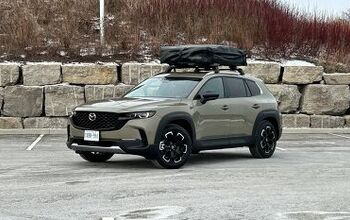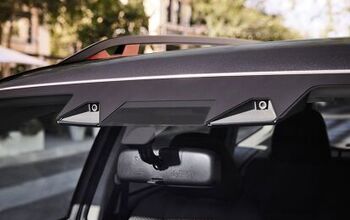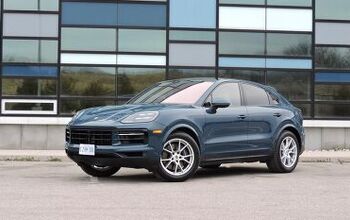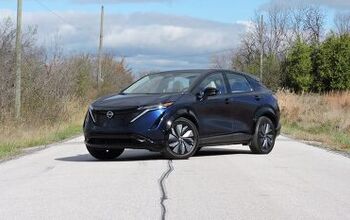2010 Jeep Patriot Off-Road Review
In the final installment of our tail-end winter off-road series, we find ourselves behind the wheel of the Jeep Patriot. Like the Compass, the Patriot is a car-based design, utilizing a version of the same GS unibody architecture and therefore incorporates all-independent suspension and shares the same front-drive powertrain, namely the 2.4-liter 172-horsepower, four-cylinder engine and CVT transmission. (A 158-hp 2.0-liter motor and five-speed manual gearbox are new for 2010). However, given its position in the Jeep brand hierarchy, the Patriot is also designed with a bit more off-road capability in mind than the Compass. As a result, it’s available with two four-wheel drive systems. Needless to say, we elected to test both.
FAST FACTS
| 1. The Patriot is the only car based Jeep to receive a Trail Rated designation. |
| 2. A 158-hp, 2.0L four-cylinder and five-speed gearbox are new additions for 2010, but the 172-hp 2.4L is standard on 4×4 models and is a better buy. |
| 3. Trail Rated versions boast an extra inch of ground clearance and standard front tow hooks. |
| 4. Fuel economy is rated at 23/28 mpg (city/hwy) with the 2.4L four-cylinder and 5-speed manual, but drops considerably with the CVT automatic, rated at just 21/25 mpg for front-drive models and 20/22 mpg for AWD models. |
| 5. Patriot pricing starts at $18,425, with AWD models priced from $20,175. |
The first, under the Freedom Drive I label, consists of an active system, much like that found on the Compass. Although it constantly seeks the maximum amount of traction and alters torque split depending on which wheels need it the most, the driver can also lock the center coupling in order to gain consistent traction on slippery surfaces or steep hills, aided by placing the CVT transmission in low gear, or utilizing first or second on the five-speed version. It’s quite capable, all things considered, and during our slippery and slushy off-road excursion in the snow-covered North, we never got stuck. There always appeared to be ample grip available.
BUT WAIT, THERE’S MORE
The Freedom Drive II system goes a step further. To begin with, it adds an inch of ground clearance, designed to provide greater articulation when boonie bashing (i.e., not getting wedged in gulleys or sustaining undercarriage damage from rocks) as well as providing greater capability when wading through river fords (high mounted drivetrain vents also help on the latter).
In addition, the Freedom II 4×4 system requires the CVT as a mandatory option, but the transmission incorporates a special low range, to assist with rock crawling. There’s also a hill start assist and hill descent control feature, plus other stuff normally found on hardcore off-roaders like skidplates, tow hooks and front foglights.
Our Freedom Drive I equipped Sport model, featured the 2.4-liter motor and CVT. Engaging low range and locking the center diff coupling, it was ready to venture off-road. Given that we had quite a few inclines to contend with and that nearly all of them were covered in slippery snow and ice, it would be interesting to see how the little Jeep faired. Torque and throttle was never a problem – with 165 ft-lbs of torque available the Patriot was able to make the most of the CVT’s low range. Steady throttle input resulted in a good amount of grip, even on inclines. The Hill Start Assist feature was also welcomed.
On the steepest section of the trail, we stopped. Even though the conditions were slippery, the Jeep didn’t move, it just held steady. The biggest issue was getting traction again. In tail end wintery conditions, where the ground is beginning to soften, but there’s still ice, you can get a bit bogged down, no matter what kind of rig you’re driving.
To give the Patriot credit, it hooked pretty well – we didn’t have to back up down the hill. In many respects, it behaves a lot like the Compass, the steering is nicely geared for off-roading, taut enough that you don’t feel serious bump steer, especially when going down slopes. The four-wheel discs provide ample braking ability, though the ABS is quite aggressive – especially on our longest descent, which was laced with ice. Pedal to the floor and it went into overdrive, still it proved that you can’t defy physics and stopping ability is directly related to the level of momentum.
BETTER THAN EXPECTED
The Freedom II equipped Sport was next. Given its Trail Rated designation, we were interested to see if this one would live up to the name. What was noticeable, almost the instant we hit the trail, was improved grip with tires that are much better suited. The extra inch of ground clearance might not seem much, but in the boonies it makes a difference.
Following the exact same route, the Trail Rated Patriot, felt slightly more confident. On one section, which was by now developing fairly deep ruts, it plowed on through with greater aplomb and on the far side a steep descent, with a 35-degree roll angle, saw it clear a big snow/mud bank more effectively than the Compass or regular Patriot. But the best part about this truck – the Hill Descent Control. Get to the top of the crest; press the button and watch. The HDC was superb, there was barely a need to touch the brakes, all we had to do was steer; the Patriot’s driveline did the rest. Going down the hill, the little truck was steady and smooth, the HDC proving to be just as good, if not better than on other more expensive SUVs, marketed as serious off-roaders.
THE VERDICT
Patriots are offered in two trim levels, Sport and Limited, with a choice of front or 4WD. In terms of pricing for the four-wheeler models – they start at $20,175 for the Sport and a fairly meaty $25,180 for the Limited. The latter adds such features as standard air conditioning, one touch power windows, tinted glass, electric folding mirrors and most importantly – for this article –17-inch wheels and all terrain-tires. Sure this helps push the sticker price higher, but at the end of the day, either of these rigs, especially equipped with the Freedom II Drive, makes for a fairly shrewd buy. they combine decent off-road capability, with on-road, car-like refinement and handling, plus decent fuel economy – 23/28 mpg gallon is possible, even with 4WD. (Buyer be ware, however, as CVT equipped models don’t get near the mileage).
For those who think a car based “truck” doesn’t warrant a Trail Rated designation, then clearly they haven’t driven a Patriot off-road.
RELATED READING
2009 Jeep Patriot Review
2010 Jeep Compass: Off Road Review
2009 Subaru Forester 2.5X Review
2010 Chevrolet Equinox 1LT AWD Review
2010 Hyundai Tucson: First Drive
LOVE IT
- Freedom Drive II delivers a serious amount of off-road capability
- Low range on the CVT transmission well matched to engine speed
- All-Terrain tires
LEAVE IT
- Base 2.0-liter four is just about pointless
- Unibody structure limits capability
- Standard ground clearance can be a issue
More by Huw Evans
































Comments
Join the conversation
You guys really need to take the updated version of this vehicle out and give it a truly open-minded review. I have had a 2013 for several months now and having owned a wide variety of both car and truck based SUV's is by far the best. After reading the expert reviews, I almost did not even both with this vehicle, but it is truly a wonderful and capable vehicle.